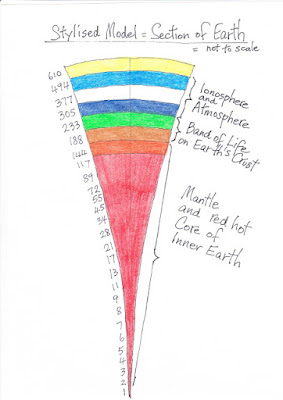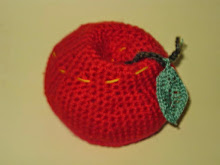The description "eternal protocols" describes the essential Patterns we can use when crocheting or knitting the Fibonacci Series. It is remarkably distinct and I was excited to discover this for myself.
This is the correct Table.
For example. Take 610 to 987.
We need to add 377 to 610. Divide 610 by 377 = 1.61803....
So we have to increase a certain number of stitches.
This was figured out in a different way back in 2010.
the Equation we found was
F(n) = 2 x F(n-2) + F(n-3). and it holds here.
This is a simplified Pattern for knitting or crocheting.
Cast on 610 stitches,
knit in accordance with Pattern,
you can put one plain row in between each decrease row.
Just make sure the balance is kept, with 2x stitches in the middle.
When knitting it depends how many stitches fit on the knitting needle;
work is shaped by decreasing- working the equation backwards.
This green work is done in fine crochet cotton.
You can crochet beginning with small numbers.
------------------------------------------------------------------------
There is a second way to build the Fibonacci Series, from 2010; the Vortex.....
unit is 4 to 7 or 13 to 21 as follows:-
Please click on image if you need to enlarge it.
Also, if you wish to copy it, click on it and then right click. Save as.....doc, or copy onto Word.
Or save link as....put it in downloads or favourites.
NB. There is a
third way to assemble the fibonacci Series in knit or crochet and it involves the Equation using number 9 or 18; work is still to be developed.
Reference is 26/5/2011 The Giant Clam.
-----------------------------------------------------------------
This one is 10946 ! Crocheted using Equation Fn = 2F(n-2) + F(n-3) as in first description. It was published 5/3/2011 in Horns, tusks, fangs and thorns, spines ans prickles .
This one is also 10946;
placed on a smooth surface, it naturally conforms into a 2 hemisphere, a brain-like shape.
---------------------------------------------
Instructions for Making a Model of a Spiral "snail like" Shape.


1. CROCHET
You can use any kind of yarn - eg No 8 crochet cotton, any ply wool
Use crochet hook of desired size - eg No 2
You can do any kind of crochet stitch - single, double, half treble, treble, double treble, etc.
To begin, crochet 5 chains
crochet into 3rd loop twice -makes 2 stitches
****Begin every row with 2 chains.
row 1........ crochet in 1st loop x2, crochet 1x in next loop -makes 3 stitches
row 2........ crochet x2 into next 2 loops, crochet 1x into next loop ---makes 5 stitches
row 3........ crochet x2 into next 3 loops, crochet 1x into next 2 loops ---makes 8 stitches
row 4........ crochet x2 into next 5 loops, crochet 1x into next 3 loops ---makes 13 stitches
row 5........ crochet x2 into next 8 loops, crochet 1x into next 5 loops ---makes 21 stitches
row 6........ crochet x2 into next 13 loops, crochet 1x into next 8 loops ---makes 34 stitches
row 7 ........crochet x2 into next 21 loops, crochet 1x into next 13 loops ---makes 55 stitches
row 8........ crochet x2 into next 34 loops, crochet 1x into next 21 loops ---makes 89 stitches
row 9........ crochet x2 into next 55 loops, crochet 1x into next 34 loops ---makes `144 stitches
row 10........ crochet x2 into next 89 loops, crochet 1x into next 55 loops ---makes 233 stitches
This is enough to make the blue green model of snail in photo this post.
Fold crochet work in half and sew it up, leaving opening such as a snail has. The work configures into a spiral which needs to be gently padded as you go.
You can use any kind of padding such as wool fleece or cotton wool, etc.
2. KNIT
You can use any kind of yarn eg crochet cotton or wool and any suitable size knitting needles. The brown snail in photo was made in 8 ply wool; use No 8 or 11 or so size needles.
row 1........ cast on 233 stitches
row 2........ knit 2 tog x89, knit 55
row 3........ purl 2 tog x55, purl 34
row 4........ knit 2 tog x34, knit 21
row 5........ purl 2 tog x21, purl 13
row 6........ knit 2 tog x13, knit 8
row 7 ........purl 2 tog x8, purl 5
row 8........ knit 2 tog x5, knit 3
row 9........ purl 2 tog x3, purl 2
row 10...... knit 2 tog x2, knit 1
row 11....... purl 2 tog x1, purl 1
row 12....... knit 2 tog
row 13....... finish off.
Fold in half and sew together, gently padding as you go
and you have a nice simple snail model just like the brown model in the photo image here,
in accordance with the Fibonacci series of numbers.
If you are more adventurous, you can make models with 377, up to any Fibonacci Number.
****This last was originally created and posted in 2010.
I am reposting some older material, to make it easier for people to follow the data.
**********************************************







































